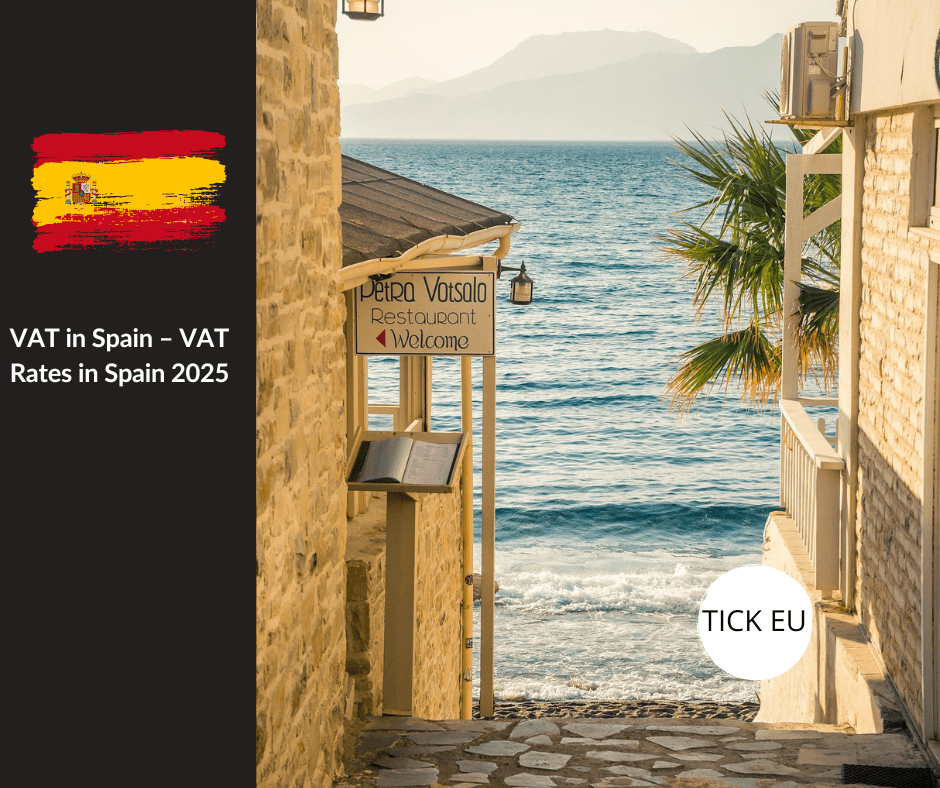Spain is not only a favorite holiday destination for many Europeans but also an important market for trade and services. If you run a business, operate in e-commerce, or simply plan to start activities in this country, it’s worth understanding how VAT works in Spain. Below you’ll find a complete guide to VAT in Spain — updated for 2025. We explain what VAT in Spain is, how much it is, the rates, who must register, and how to settle it.
What is VAT in Spain and who must settle it?
VAT in Spain (Impuesto sobre el Valor Añadido, abbreviated as IVA) is an indirect tax on goods and services, modeled on the EU system. It applies throughout the country — both on the Iberian Peninsula and the Balearic Islands. However, it does not cover the Canary Islands, Ceuta, and Melilla, which have separate tax systems.
Every entrepreneur providing services or selling goods in Spain should understand the rules for settling Spanish VAT. This obligation applies to both local and foreign companies. Spanish VAT concerns, among others:
B2C sales to customers in Spain (e.g., e-commerce),
Services provided to Spanish companies or private individuals,
Import and export of goods,
Intra-community transactions.
What is the VAT rate in Spain in 2025?
Spain has three basic VAT rates, unchanged for 2025:
Standard rate – 21%
This is the default VAT rate in Spain, applying to most goods and services such as electronics, clothing, cosmetics, telecommunications services, transport, and hospitality.Reduced rate – 10%
Applies to services like hospitality, unprocessed food, non-alcoholic beverages, tickets to cultural events, passenger transport, and certain pharmaceutical products.Super-reduced rate – 4%
The lowest VAT rate, applied to essential goods and services like bread, milk, books, newspapers, prescription medicines, and aids for people with disabilities.
Thus, the VAT rate in Spain depends on the category of product or service. Knowing the correct rate is key when pricing products, issuing invoices, or calculating margins.
When must a foreign company register for VAT in Spain?
If you do not have a business registered in Spain but have customers there, you may be required to register for Spanish VAT. This most often applies to: e-commerce companies exceeding the €10,000 threshold (for B2C sales), companies storing goods in Spain, B2C service providers (e.g., online training, consulting, digital services), participation in trade fairs or industry events (in some cases), or import/export of goods. Registration is done through the Spanish Tax Agency (Agencia Tributaria). After obtaining a NIF-IVA number, you can legally issue invoices and settle VAT in Spain.
How does VAT settlement work in Spain?
VAT settlement in Spain may seem complicated, especially for foreign companies, but it is well-structured. Basic info:
VAT returns (Modelo 303) are usually filed quarterly (or monthly for larger companies).
A Spanish NIF number, electronic signature, and account in the Spanish SII system are required.
VAT payment is due by the 20th day of the month following the settlement period.
Companies can apply for VAT refunds in Spain (Modelo 360 or 361) if they have overpaid.
Foreign entrepreneurs are advised to use local advisors or firms specializing in international VAT settlements.
Examples of VAT rates applied in Spain
To better understand, here are examples of VAT rates for different cases:
Buying electronics – 21%
Restaurant meal – 10%
Hotel stay – 10%
Buying a book – 4%
Prescription medicine – 4%
Importing a car – 21%
The applicable VAT depends not only on the product type but also on who buys it (company or private individual) and for what purpose.
Can Spanish VAT be deducted?
Yes, the Spanish tax system allows VAT deduction provided that: the expense is related to business activity, the invoice contains a valid NIF, and the tax was declared in the VAT return. Deductions are possible for goods purchased for resale, marketing services, office equipment, or rental of premises for business. However, the Spanish tax authorities are very strict about errors — incorrect invoices or delays may lead to denial of deduction rights.
VAT OSS and doing business in Spain
For companies selling online in B2C mode across the EU, the VAT OSS (One Stop Shop) system allows settling Spanish VAT without local registration. However, registration for OSS must be done in the company’s home country.
If you use OSS, you don’t have to register separately in Spain but must apply the correct Spanish VAT rate (21%, 10%, or 4%) for transactions with Spanish customers.
Changes and trends: VAT Spain 2025
No radical changes in VAT rates are planned for 2025. The three levels of tax remain the same. However, more companies are implementing electronic reporting systems, and the Spanish tax office invests in automation — so it’s worth monitoring updates, especially regarding e-invoices and the SII system.
What is VAT in Spain and how to navigate it?
VAT in Spain is an obligation to take seriously but not a system to fear. Thanks to clear rules and support from local advisors, you can easily conduct sales or business in Spain. Remember the applicable rates: 21%, 10%, and 4%, and comply with the tax authorities’ requirements. If in doubt, consult a VAT expert to avoid mistakes and focus on growing your business.


